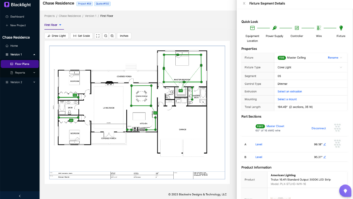
Dean Clough
Frustrated by what he called the “trench warfare” that he had to wage every day integrating home technology, 15-year custom install veteran Dean Clough decided to call it quits. But then the San Francisco business owner had a “Hail Mary idea” that he hopes can help save the middle market for integrated home projects.
Under his old company brand, Casa Integration, Clough has launched an online tool that makes the selection and installation of an entire new home technology suite easy and far less expensive. According to his plan, an architect, either with their client or independently, can visit www.casaintegration.com, answer a few simple questions about what technology is desired in the home, and the site does the rest—equipment lists, budgets, cabling specifications, and helpful information for bringing it all together.

Casa Integration introduces itself
The new tool, which is available now, automatically takes care of basics like Wi-Fi and fundamental wiring, and then asks what other features are desired—TVs, music throughout the home, lighting control, motorized shades, surveillance cameras, and “smart” thermostats. Clough said that that the online tool is perfect for a 1,500- to 5,000-square-foot home.
“Frankly, I hope to make what I’ve been doing for the last 15 years mostly obsolete,” Clough said. “I came to realize that the methods employed by me and nearly everyone else in the same business, in the end, fail our clients. They’re too complicated, too intimidating, and not reliable enough, especially given the expense involved.”
Clough said that he’s grown weary of the traditional approach to custom installation, where “expensive specialists” install “a lot of complex gear” that while often providing useful and fun capabilities, tends to be expensive to install and to maintain.

A sample page of the proposal
Clough believes that the industry is at a “watershed moment” where individual products are now so capable that by carefully selecting the right pieces, the vast majority of people will be very happy with the outcome.
Casa Integration has meticulously distilled things to the point where everything can be installed by the building team, a handyman, or even by motivated DIYers. Most importantly, it enables the architect to direct the building team in this ever-more-critical area of the homebuilding process.
Clough at first tried adding a “managed services” component to his traditional CI business, but realized “that’s only putting lipstick on the proverbial pig.” The problem, he realized, is the residential technology integration industry itself. “There is a steadfast refusal to accept how far technology has progressed, and therefore, the vast majority of people can have capabilities they never dreamed of—but without an integrator,” he said.
Clough’s design program sticks to tried-and-true “mainstream” brands and technology, including Sony TVs, TiVo DVRs (with the TiVo remote), Sonos Playbars and subwoofers, Lutron RadioRA2 lighting control (and Lutron’s HomeControl app)—but no major control system layered on top.
“In our approach, there are no custom controls. There are no racks,” Clough said. “There’s a music shelf with six Sonos Connects sitting on it. So when the music stops playing in the dining room, there is no mystery about where the music is coming from. The Sonos is either working or it isn’t. There is not a rack of processors that the homeowner doesn’t even understand.”
The company’s revenue comes strictly from each purchase by an end user or architect of a $395 design through the Casa Integration website. A free version of the design package gives a client a taste of what a design would look like, but lacks the specific installation documentation necessary to pull the system together in the correct way.
“For $395, we give the cookbook for the entire thing,” Clough said. “I know that from my perspective this build package will absolutely give the building team what they need.”
The build package includes cable specs, termination instructions for the cable, and “pictures of every single thing” that has to happen during rough in, during trim out, and during final.”
Clough acknowledged that his design system is not meant for every home. “This is nowhere near the right approach for a 10,000- to 1,5000-square-foot mansion,” he said. “There are plenty of people that want the toys or want Crestron or Savant. But, there’s got to be something between the straight DIY approach or leaving it to the electrician to screw it up, and the $200/hour integrator that’s trying to make you get [custom control system]. I hope that this hits a sweet spot between.”







